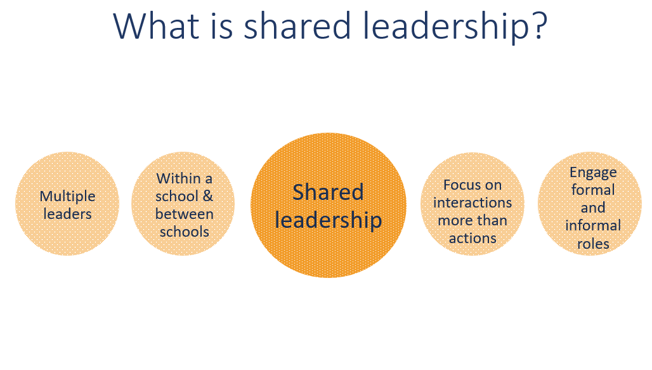Leadership is a social process of influence, mobilising others’ efforts to reach specific objectives serving a vision.

- It is about learning together, constructing meaning and knowledge both collectively and collaboratively. In this sense, coherent and well-constructed school leadership will enable teachers, school administration staff, directors, and heads of departments to generate ideas together, reflect, and make sense of their work in light of the shared believes they have. This, in turn, will help them define concrete actions and goals that grow from their common understanding.
Why do we focus on shared leadership:
How does shared leadership look like when it works?
- The first is it is the key lever of organisational performance. You take it out and the chances
- The second is, what we’ve learnt is in the most successful organisations you have what’s called distributed leadership..
Distributed leadership is not giving away your power or
authority or control. It’s saying, As a leader, how can I create the conditions in my organisation where people will feel able to offer their expertise?
ACTIVITY:
The leader’s main role is to grow other leaders?
Do you agree that the school leader’s main role is to grow other leaders? If yes, how, and if no, what are the roles of a school leader?
In my opinion, a leader is a person who influence other pepople and persuade them to do something. A leader can be a teacher, who influences the lifes of the students, the teacher as a leader makes the dfference for these children.
So, the leader's main role is to grow other leaders, is the power and the capacity to make others strong and efficient, to make the change, to solve problems, to inspire others.
What are the building blocks of shared leadership in school?
ACTIVITY:
What are the benefits and risks of implementing shared leadership in your school?
What do you think would be the benefits to your school when applying shared leadership? Provide 3 concrete examples of how shared leadership practices can benefit your school (teachers, pupils, educational staff). What would the risks be in implementing a shared leadership approach? Provide 3 concrete examples on the risks you would face in your school.
Benefits:
Increasing motivation
Better collaboration
Cultivate a healthy school culture
Shared responsibility
Pluralism of ideas
Risks:
Lack of time
Overworking
Fear of changes
Conflicts by different opinions
Activity:
- What would you like to understand more in-depth in the next sections?
I would like to learn about real life problems at schools around Europe and how people have dealt with that. I think that all schools have approximately the same problems, like unwilling colleagues, luck of funds, misunderstandings with the parents, low undestanding by the administration. How some schools have dealt with that in the past? Are there any good examples? Are there any successful results?
Additional extra material
Video about shared leadership and how it works in schools: https://www.youtube.com/watch?v=09SMGXTXVww&feature=youtu.be
Video about Best Practices in Shared Leadership: Developing Student Interventions with Joe Balleweg: https://www.youtube.com/watch?v=-bEzoQfT9_0&feature=youtu.be




No comments:
Post a Comment